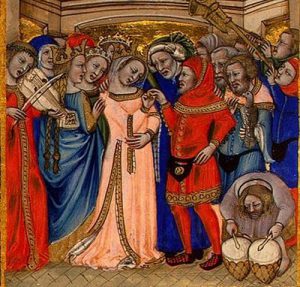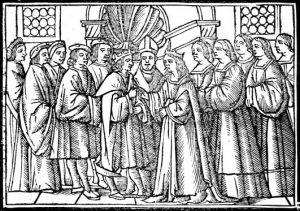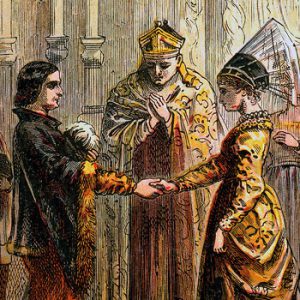During the time of The Canterbury Tales (14th Century), marriage looked a little different in England than it does in today’s culture. While there are some similarities, there are definitely distinctions that set it apart from the marriage culture of the present.
Back in those days, all that was really required to get married was verbal consent, and not being related to one another. They could even be twelve years old and get married. There was no official certificate or anything such as that in order for two people to get married. Another difference was that money and status played a much bigger part in marriage than it does today. Things such as money, land, and family names/alliances were much more important to the families of the people getting married than they are to families today, (although there are certainly those families who place a great deal of stock into these matters), but even so, the wedding couple did not need the consent of their families in order to get married, although wishes of the parents were a heavy influence. Also, as far as money and land are concerned, generally these items were in control of the husband, but there were several different ways in which the wife could take control of the land/money, such as if the husband had died, and not given all their land away. Widows were actually both financially and legally independent.
The act of getting married could be just as simple as saying “We agree to get married,” but there were definitely more elaborate weddings more like what we would see today, although these bigger weddings were often the result of wealthy/prestigious people getting married.
Church life had a great deal to do with marriage. God Himself could be the witness for your marriage and that was good enough to be considered married. There were also many religious rules set in place regarding marriage such as having to be married to other Christians, instead of to non-believers.
There was also no divorcing like in today’s time. The only ways marriages ended in this time were either by death, or by managing to prove there was never a marriage to begin with.
Love was also not necessarily the main reason behind getting married. The desire of getting married was more of keeping up with the social norms of the time than it was about finding true love or anything of that nature. This being said, there were definitely plenty of cases when love was actually in play when two people decided to get married.
As far as similarities, there are several parts of weddings/marriages that were still used today such as the repeating of vows, weddings rings, and so forth. The marriage was pretty standard in senses like, they were only married to each other and not multiple people, they lived together, and they had families together. In today’s culture, marriage still carries on much the same as it did in 14th century England, although the big difference are that there are many more laws surrounding marriage today, and also that the reason for marriage often revolves around love between the couple, rather that just getting married for the sake of getting married.
Marriage was often a frequent topic in stories of the time, such as The Canterbury Tales. Often these tales may take creative directions when describing the marriages in the story, and sometimes may not depict marriage in the most accurate way. So while marriage was maybe more of a simpler ideal in those times than it is today, it was still an ideal big enough to incorporate into many stories, and was dynamic enough to creative narratives surrounding the idea that would draw the interest of all types/classes of people. Even the modern stories of today do the same, taking the very general idea of marriage and love, and taking a creative direction with it, making a narrative that is intriguing because marriage is such a key part of our culture.
Helpful Links:
http://crossref-it.info/textguide/The-Wife-of-Bath’s-Prologue-and-Tale/30/2014?jump=h2-4
http://www.historyextra.com/article/feature/love-and-marriage-medieval-england-customs-vows-ceremony
http://www.enotes.com/homework-help/explain-rules-marriage-during-fourteenth-century-469267
http://english.fsu.edu/canterbury/
http://www.medievalists.net/2011/03/09/an-english-royal-wedding-from-the-middle-ages/




